What Do Octopus Eat?
The octopus is one of the most fascinating creatures found under the sea. A member of the order Octopoda there exists nearly 300 species of octopus worldwide. While similar to squid, the eight-legged octopus is its own creature entirely. They live in various aquatic environments, from coral reefs to the dark seabed of the deepest parts of the ocean. Thanks to their complex nervous system, they represent one of the planet’s most intelligent invertebrates. At the same time, octopus is a valuable food source for many people around the world, and they serve an important role in maintaining the health of their local ecosystems. Octopuses come in a range of size, from microscopic to the size of a small boat. Given their widespread distribution, importance, and size, octopuses in one region can differ dramatically from others. This variance causes us to ask the question, “what do octopus eat?”
In this article, we’ll examine the dietary habits of octopuses. First, we’ll begin with a conversation of what most octopuses generally like to eat. Then, we’ll examine how octopuses hunt for food using their senses and different tactics. Next, we’ll compare what octopuses eat in the wild versus what they eat as pets. Finally, we’ll briefly talk about what baby octopuses eat. So, let’s dive in and answer the question, “what do octopus eat?”
What Do Octopus Like to Eat?
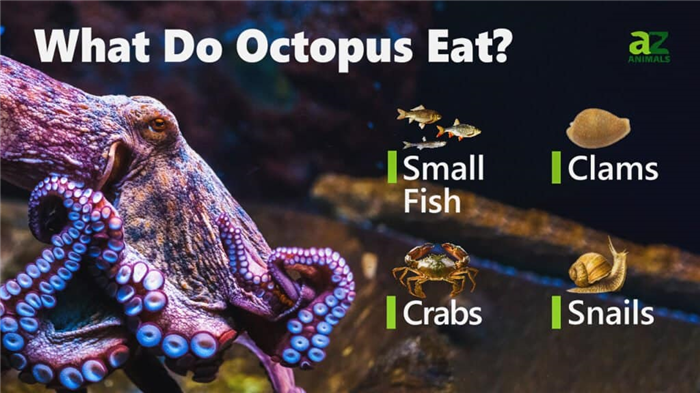
Octopuses are carnivores and typically eat fish, clams, crabs, and snails.
Nearly all species of octopuses are predatory carnivores, meaning that they eat animal matter to survive. Generally speaking, octopuses tend to target prey that is the same size or smaller than themselves. They prefer to overwhelm their prey, so will only rarely attack something larger than themselves, usually when defending themselves or when they feel threatened. Overall, crustaceans, mollusks, and fish are among the most common foods eaten by octopuses. On the inverse, they tend to avoid creatures with natural defenses such as rock scallops and abalone. Octopuses require a lot of protein and some species, such as the Giant Pacific Octopus, will eat between 2% to 4% of their body weight in a single day. Most octopuses are not picky eaters, but many do show preference for certain types of food. We’ve compiled a list of 10 foods that most octopuses like to eat. These 10 foods include:
- Crabs
- Lobsters
- Shrimps
- Fish
- Shark
- Clams
- Snails
- Scallops
- Worms
- Other cephalopods
How Do Octopus Hunt For Food?
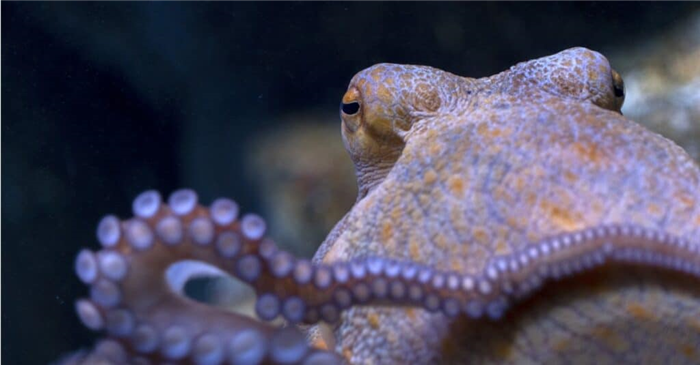
The suckers on the arms of an octopus are full of sensitive receptors that enable to see, feel, smell, and taste.
Octopuses possess unique nervous systems that make them very adept at navigating their environment and finding food. They have keen vision and can see well both in light and extremely dark conditions near the seabed. With their polarized vision, they can control the amount of light that comes into their eyes, making them able to see in both bright and low light. Aside from sight, octopuses rely greatly on their amazing sense of touch. Each of the suckers on an octopus’s eight arms contains thousands of neurons that allow them to interpret information through touch. Additionally, research suggests that their suckers are equipped with receptors that allow them to taste and smell their environment. Simply by feeling their food, they can discern its taste and determine if it’s a worthwhile meal. These receptors are so sensitive that they can detect trace chemicals, and may also be sensitive to light.
Depending on the species and where it lives, octopuses use different tactics to find prey. Bottom-dwelling octopuses tend to move along the seabed and feel about with their arms. They’ll reach their arms inside cracks or other crevices, and wrap on anything they find. Occasionally, they may also propel themselves toward their target by expelling a jet of water. Meanwhile, some bioluminescent octopuses trick their prey into swimming directly into their mouths using the photophores on their arms. All octopuses possess some sort of toxic venom which they use to subdue their prey. The octopus delivers this venom through its beak and helps to break down their prey’s flesh. This helps the octopus to more easily eat its meal by making the flesh more supple and easier to tear. On the other hand, some octopuses take a novel approach and simply swallow their prey whole.
What Do Octopus Eat in the Wild?
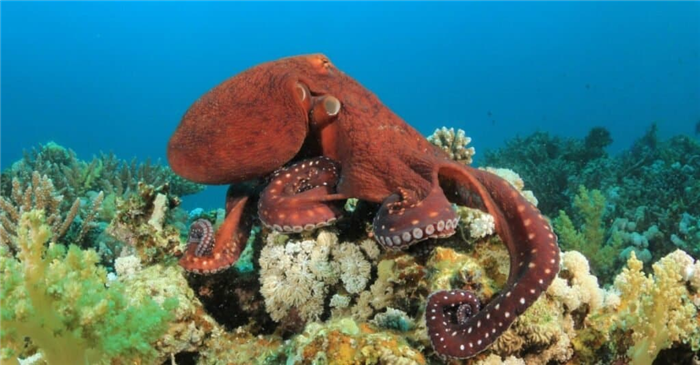
Octopuses possess potent venom that they use to break down their prey’s defenses.
In the wild, an octopus will eat just about anything that it can find while crawling across the seabed or swimming through the open water. Benthic octopuses mostly eat animals that spend their time along the seabed or hiding in coral reefs. Common prey targeted by these octopuses include crustaceans, worms, and mollusks. Within these classifications, crabs and lobsters are some of the most choice prey, along with whelks and clams. These octopuses may also direct small fish, but not as often. Meanwhile, octopuses that hunt in the open ocean are more likely to feed on fish, as well as shrimp and other cephalopods. Octopuses will occasionally practice cannibalism and eat other octopuses. This usually happens when the hunter is much larger than the other octopus species. Additionally, especially large octopuses will also target sharks. While stories of killer octopuses exist, it’s unlikely they’d ever eat a human.
What Do Pet Octopus Eat?
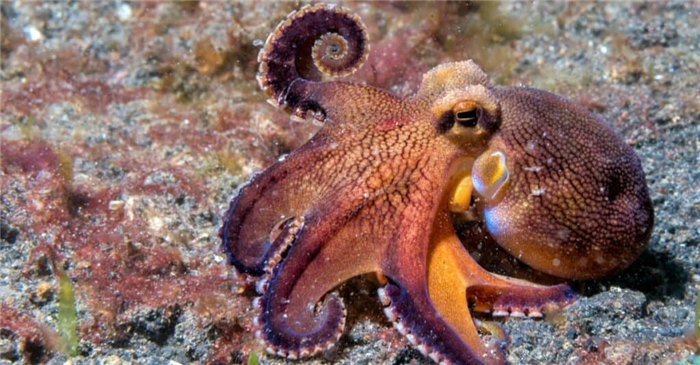
Octopuses mostly eat live prey, but pets may be fed a small amount of thawed frozen shrimp.
Thanks to their intelligence, beautiful colors, and unique appearance, many people choose to raise octopuses as pets. If you choose to raise a pet octopus, you’ll need to know what to feed your pet cephalopod to keep it alive. They are high-maintenance pets, and require plenty of room and attention. Octopuses require some live food for optimal health, but can also live on pre-killed food. As such, it’s safe to include thawed frozen shrimp in the diet of your pet octopus. That said, live shrimp, crabs, and small fish should make up the bulk of its diet. You’ll want to feed your pet octopus once a day about six days a week to ensure it gets enough food without overeating. Make sure to replace uneaten food often and to regularly clean your pet octopus’s tank. Always check with a local expert before introducing new food to your pet octopus.
What Do Baby Octopus Eat?
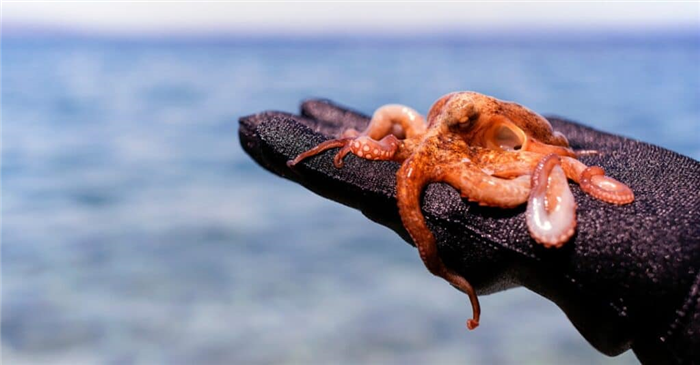
Baby octopuses typically feed on plankton and other small organisms until they grow large enough to take down bigger prey.
Baby octopuses are also known as larvae. Shortly after mating, the male octopus will die, leaving the female adult octopus to tend to the eggs. Once the eggs hatch, the female will also die, leaving the newly hatched babies to fend for themselves. Larval octopuses appear like miniature versions of their adult selves. At first, these baby octopuses will drift into plankton fields where they begin to feed. Some of their favorite foods include plankton, copepods, small crabs, and sea stars. They are ravenous eaters, and quickly gain weight. Over the course of a week, an infant octopus may double in size. Upon growing large enough, a young octopus will eat the same food as an adult octopus. Baby octopuses are notoriously picky compared to adult octopuses, and often die of starvation as a result, so are rarely raised in captivity.
What Does an Octopus Eat? – Lesson for Kids
Octopus’ diets vary with their species. Discover the anatomy an octopus uses to catch and consume its prey, as well as the specific diets of the dumbo, common, and giant Pacific octopus. Updated: 01/12/2022
You are scuba diving around a beautiful coral reef when suddenly a dark shadow glides over you. You look up, but you don’t see anything. Perplexed, you continue to investigate the coral when, directly in front, you see it: a spectacularly large sea creature with many legs. Wait, make that eight legs. That is when you realize you have come face to face with a giant octopus! What do you do? Are you in danger? Will it eat you? Well, let’s delve into the world of the octopus and find out.
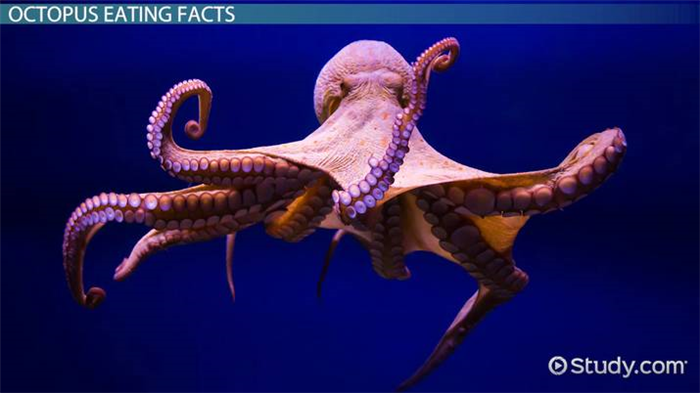
An error occurred trying to load this video.
Try refreshing the page, or contact customer support.
You must c C reate an account to continue watching
Register to view this lesson
As a member, you’ll also get unlimited access to over 84,000 lessons in math, English, science, history, and more. Plus, get practice tests, quizzes, and personalized coaching to help you succeed.
Get unlimited access to over 84,000 lessons.
Already registered? Log in here for access
Resources created by teachers for teachers
I would definitely recommend Study.com to my colleagues. It’s like a teacher waved a magic wand and did the work for me. I feel like it’s a lifeline.
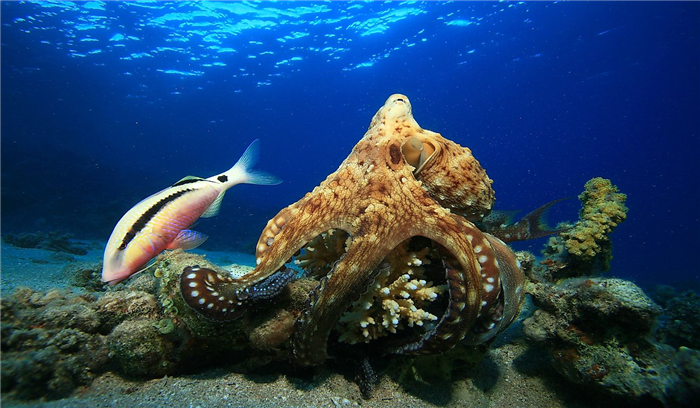
You’re on a roll. Keep up the good work!
Just checking in. Are you still watching?
Want to watch this again later?
Log in or sign up to add this lesson to a Custom Course.
Octopus Eating Facts
According to scientists, there are around 300 distinct species of octopus, which means they eat lots of different things. However, there are a few things that all octopuses have in common when it comes to eating. First, let’s look at some of those things, and then we will look at the eating habits of three specific octopuses.
- All octopuses are carnivores, which means that they are meat eaters. But their size and whether they are bottom-dwellers or tend to feed more in the open ocean affect exactly what’s on their dinner plates.
- All octopuses have beaks that they use these to tear apart their prey. The beak is made of a material called keratin, which is the same material that your fingernails and a bird’s beak are made of. An octopus’s beak is found on its underside, where the legs meet.
- All octopuses have teeth, but how many teeth they have depends on the specific species. These teeth can be found on their tongues, inside their mouths, and even on their leg suckers. These teeth, along with the help of the beak, allow them to drill holes right into shelled creatures and get out the tasty meat.
- Octopuses usually inject venom into their prey using their beaks. Each species of octopus has venom with varying levels of poison.
- All octopuses are stealthy hunters. An octopus usually drops down, pounces on its prey, and uses its legs to pull the meal in. They also move fast using jet propulsion and camouflage themselves instantly, which means they hide themselves by changing color to match their surroundings. This ability to color change in a flash makes them great predators. Also, octopuses have no bones. This allows them to fit through even the tightest spaces to make a quick attack!
Now let’s dive into a few specific types of octopuses and see exactly what they eat.
Dumbo Octopus
A dumbo octopus is named after its floppy, ear-like fins that resemble the Disney elephant character. These tiny octopuses are only about a foot big and weigh about 13 lbs. They are deep ocean dwellers, tend to move slowly, and eat creatures floating around in the current. This may include things such as small crustaceans (like crabs), worms, and snails.
The common octopus tends to live in more shallow and warmer waters. It averages about four feet in length and weighs about 22 lbs. These fast swimmers prefer to prey on crabs, clams, crayfish, and mollusks.
Giant Pacific Octopus
The giant solitary creature the giant pacific octopus live in the chilly waters of the Pacific Ocean. The biggest giant octopus ever found was 20 feet across and weighed in at 200 pounds! These giants dine on shrimp, clams, lobsters, fish, and have even been known to eat a shark or two.
Even though there are many different species of octopuses, they have many things in common when it comes to eating. They are carnivores, they use their keratin beaks and teeth to rip food, they inject venom, and they’re stealthy hunters that use things like camouflage and propulsion to catch prey. Their diet may consist of things like clams, crabs, mollusks, lobsters, and fish.
To unlock this lesson you must be a Study.com Member.
Create your account
Octopuses
Donate
Octopuses
Status: Not Listed
The octopus is a marine mollusk and a member of the class Cephalopoda, more commonly called cephalopods. Cephalopoda means “head foot” in Greek, and in this class of organisms, the head and feet are merged. A ring of eight equally-long arms surround the head. They use their arms to “walk” on seafloor. The undersides of the arms are covered with suction cups that are very sensitive to touch and taste. The sack-like body is perched atop the head, which has two complex and sensitive eyes, while the mouth is on the underside. Octopuses have a hard beak, which they use to pierce the shells of crustacean prey.
Octopuses have three functioning hearts. Two of the hearts work exclusively to move blood to the gills, while the third pumps blood through the rest of the body. Rather than iron-based blood, their blood is copper-based, which is more efficient at transporting oxygen at low temperatures and makes their blood blue in color.
Octopuses are solitary creatures excellent at camouflaging and concealing themselves. They are about 90 percent muscle, and because they lack bones, they can fit through very small spaces. Their skin contains cells called chromatophores that allow the octopus to change color and pattern. They are believed to be quite intelligent—capable of learning, using tools, and remembering locations.
There is tremendous range in the size of octopus species found in U.S. waters. The giant Pacific octopus (Enteroctopus dofleini), found off the Pacific coast of the United States from California to Alaska, is the largest octopus species in the world. It has an arm span that can reach 14 feet (four meters). The common octopus (Octopus vulgaris), found along the east coast of the U.S., is much smaller, growing up to about three feet (0.9 meters). The red octopus (Octopus rubescens), found along the Pacific coast, grows to about 20 inches (51 centimeters).
Octopuses are found in every ocean of the world and along every coast of the United States. Octopuses live in coastal marine waters and spend much of their time in dens—small holes and crevices in rocks and coral. They are generally solitary and territorial. Moray eels, fish, seals, sperm whales, sea otters, and many birds prey on octopuses. Octopuses use several different strategies to evade predators—they camouflage themselves by quickly changing their skin color, they make colorful displays or eject ink to startle or confuse potential predators, they squeeze into small crevices to escape, and they quickly propel themselves through water.
Newly hatched octopuses will eat small foods such as copepods, larval crabs, and sea stars. Adult octopuses feed on crabs, clams, snails, small fishes, and even other octopuses. All species of octopus have venom of varying levels of toxicity, which they inject using a beak that is similar to a bird’s. They typically hunt at night, pouncing on their prey and wrapping it in the webbing between their arms. They penetrate hard-shelled prey with their beaks.
The male initiates mating by approaching the female. He has a specialized tip at the end of one arm that transfers sperm to the female’s oviduct. The female looks for a suitable den site and lays the eggs, attached in chains, to the rock or coral or the den. The eggs can number in the hundreds of thousands for some species. The female guards and cares for the eggs, aerating and cleaning them until they hatch. As soon as they hatch, the young are able to swim, eat, and produce ink. The male parent dies soon after mating and the female survives only until her brood has hatched. An octopus will generally live for about one to three years, depending on the species.
Octopuses are spread throughout a large ocean area and are solitary, which makes it difficult to determine the status of their populations. They are not believed to be under threat, but they are sensitive to pollutants. Scientists are still discovering new species of octopuses.
Octopuses move using jet propulsion—they suck water into their mantle cavity, then quickly contract their muscles to force the water out through a narrow siphon, aiming the water to steer in a particular direction.
Alaska Fisheries Science Center, NOAA Fisheries, National Oceanic and Atmospheric Administration
Animal Diversity Web, University of Michigan Museum of Zoology
Maui Ocean Center
Monterey Bay Aquarium
Smithsonian’s National Zoo and Conservation Biology Institute
What Behavior Can We Expect of Octopuses?, by J.A. Mather and R.C. Anderson, The Cephalopod Page
What Do Octopuses Eat? Obvious Octopus Facts Everyone Should Know!
Show all photos 1
Published on Nov 10, 2021
Get inspiration for education!
Subscribe for virtual tools, STEM-inspired play, creative tips and more
Octopuses are soft-bodied animals whose lifespans vary from one to two years.
Every octopus species has eight legs. This animal species use only two for movements while the other six are for food foraging. Octopuses have large black eyes, three hearts and blue blood, which might sound weird to some.
What do octopuses eat? Can an octopus eat a shark? Can an octopus eat a human? If you too have these interesting questions, then read on to know about the diet of the common octopus species in the sea.
Afterward, do read how many tentacles does an octopus have and the difference between octopus and squid.
Can an octopus eat a human?
Can an octopus eat a human? Are these marine animals really that dangerous? Can these large animals adapt themselves to feeding only on humans?
Octopuses prefer living in deep and shallow waters in the ocean and are very strange-looking. These blue-blooded creatures only come towards the surface when these marine predators want food. This usually happens around dawn and dusk. Since they live in oceans, they eat their neighbors without a doubt. Neighbors include shrimps, crabs, lobsters and sometimes bigger creatures such as sharks or big fishes around them. But what about humans? Can an octopus adapt to eat a human?
Octopuses tend to avoid humans as they live in deep oceans, sometimes at depths of more than 4002 ft. (1220 m), and not all humans are such deep divers. But there are many reports of octopuses attacking humans. They create powerful suction with the suckers on their body and hold onto humans tightly.
Are octopuses picky eaters?
Octopuses live so deep that they don’t have many options or choices of what to eat. They are generally not picky eaters as they don’t have many options deep down in the ocean.
But still, they have a wide range of food that they do eat. They are known to eat bigger fishes such as sharks and dolphins. They also enjoy easy targets around them, such as crustaceans like clams, shrimp, snails, lobsters, mollusks, and plankton.
Easy targets include crabs and lobsters. They can be selective about their favorite food but will adapt themselves to the best possible alternative present around them in the tough times. In captivity, you can train them to eat something beyond their typical diet, and they can adapt to it really easily, but do not try this too often as they can get aggressive.
How do octopuses taste what they eat?
Do you also think about how octopuses taste their food? Do these sea animals also have taste buds like humans?
Well, it’s quite not as simple as it seems. Octopuses are more evolved than humans and work very weirdly. The arms of octopuses work in many ways. An octopus can swim, crawl, and suck through its arms. Also, octopuses can taste their prey before they eat it. This is possible because of their arms. The arms provide them with the functionality of licking their prey as soon as octopuses grab it.
These ocean creatures do not have taste buds or any taste sensors in their mouth. The suckers present along their arms are more likely to work as their tongue and help them lick their prey. This is how octopuses can taste before these ocean animals eat. It is known that they taste first and then decide whether the food is worth having or not.
Do octopuses eat snacks?
Since everyone enjoys eating snacks, do these amazing predators also eat snacks? What do octopuses eat as snacks? Do they eat the same as octopuses do for their meals?
Well, octopuses are quite active when hunting on the seafloor or in shallow waters, especially when it is either dawn or dusk. This is the time when they leave their surroundings in search of food; after having their food, they return to their respective places. They do not enjoy variable diets and enjoy common elements. Snacks are what we eat in the time between meals. An octopus does not need to come to the surface if it finds enough food around to survive. They have a wide range of options for food. Their taste may vary from place to place, but they are known to adapt to where they live. Also, they only kill and eat worms they find worth eating after tasting them.
When in deep waters, they feed on crustaceans like clams, shrimp, snails, lobsters, mollusks, various fish species and plankton.
Diet Based On Location
Do octopuses eat differently when they are not in their natural habitat? Octopuses can move from one place to another easily, and their diet can be based on their location.
Yes, they do have a wide range of food choices, but these choices may vary from location to location. If they don’t find anything in deepwater, they simply move towards the surface in search of food. If nothing else, then you will find an octopus eating an octopus or a squid. Larger ones feed themselves with smaller ones.
Adult octopuses rest in dens when they are not hungry. These solitary animals with venom will move out of a den only when it gets dark at night. They blend in with the rocks in their habitat, allowing them an added advantage when they are on a hunt. They use the length of their feet to hunt for their prey and inject venom into its body.
Octopus Diet By Types
Does their diet really depend on their species? What variations can we expect? There are over 300 species of octopus. Every species does have its preferences of what to eat.
Most commonly, you will find octopuses feeding on crabs, shrimps, lobsters, and mollusks. Their diet also varies from size to size. Small octopuses or squids feed on crabs and shrimps, while a big octopus, specifically a giant pacific octopus, can eat a complete shark in one go. Different types of octopuses enjoy many different meals too, but there are some common ones too.
Octopus Diet In Captivity
You will find octopuses in the deep sea or oceans, but what if we keep them in a captive region or a big aquarium? What do they eat? Do they eat the same in deep water as they eat on the surface?
It becomes very important to take care of octopuses in captivity. They can adapt themselves, but that does not mean that you can control them every time. If given a proper diet and attention, they can easily live in captivity. Octopuses are adaptive in nature and prefer living in the wild. But that does not mean that they can eat grass or foods that we eat. They are carnivorous and prefer eating meat. They tend to eat more food in live form than in dead form. However, if you can train them, they can eat frozen or dead meat, but they generally won’t eat it. Octopuses rarely display problems in captivity if trained well with their appetite. Make sure you provide adequate area to them in captivity.
Here at Kidadl, we have carefully created lots of interesting family-friendly facts for everyone to enjoy! If you liked our suggestions for ‘What do octopuses eat?’ then why not take a look at ‘Blue ringed octopus venom’, or ‘Octopus facts’.
Written By
The Kidadl Team is made up of people from different walks of life, from different families and backgrounds, each with unique experiences and nuggets of wisdom to share with you. From lino cutting to surfing to children’s mental health, their hobbies and interests range far and wide. They are passionate about turning your everyday moments into memories and bringing you inspiring ideas to have fun with your family.
Read The Disclaimer
Disclaimer
At Kidadl we pride ourselves on offering families original ideas to make the most of time spent together at home or out and about, wherever you are in the world. We strive to recommend the very best things that are suggested by our community and are things we would do ourselves – our aim is to be the trusted friend to parents.
We try our very best, but cannot guarantee perfection. We will always aim to give you accurate information at the date of publication – however, information does change, so it’s important you do your own research, double-check and make the decision that is right for your family.
Kidadl provides inspiration to entertain and educate your children. We recognise that not all activities and ideas are appropriate and suitable for all children and families or in all circumstances. Our recommended activities are based on age but these are a guide. We recommend that these ideas are used as inspiration, that ideas are undertaken with appropriate adult supervision, and that each adult uses their own discretion and knowledge of their children to consider the safety and suitability.
Kidadl cannot accept liability for the execution of these ideas, and parental supervision is advised at all times, as safety is paramount. Anyone using the information provided by Kidadl does so at their own risk and we can not accept liability if things go wrong.
Sponsorship & Advertising Policy
Kidadl is independent and to make our service free to you the reader we are supported by advertising.
We hope you love our recommendations for products and services! What we suggest is selected independently by the Kidadl team. If you purchase using the buy now button we may earn a small commission. This does not influence our choices. Please note: prices are correct and items are available at the time the article was published.
Kidadl has a number of affiliate partners that we work with including Amazon. Please note that Kidadl is a participant in the Amazon Services LLC Associates Program, an affiliate advertising program designed to provide a means for sites to earn advertising fees by advertising and linking to amazon.
We also link to other websites, but are not responsible for their content.
Diet Of The Octopuses
There are two types of octopuses with regards to their feeding habits: bottom-dwelling octopuses and open-ocean octopuses. Bottom-dwelling octopuses primarily feed on mollusks, polychaete worms, and crustaceans such as clams, shrimps, lobsters and snails. Open-ocean octopuses feed on fish, birds, and snails. Young octopuses feed on plankton and other animal larvae. When their common source of food depletes, octopuses may feed on smaller species of octopus to survive. In most cases, octopuses hunt and feed at night. However, they may also feed during the day when prey cross their path. Octopuses are carnivorous, meaning they only feed on meat.
During feeding, the octopus uses a strong and powerful beak to bite its prey and inject it with venom. This venom does not kill the prey, but rather immobilizes it so that the octopus can easily feed on it. Once the prey becomes immobilized, the octopus uses its beak to grasp and rip the prey apart into smaller pieces. They can also use the webbed, sticky suction cups on their arms to seize prey and prevent them from escaping. The suction cups are also important for the tasting of food eaten by octopuses.
Most sources of food that octopuses prey on are enclosed in shells, which need to be removed before consumption. If the octopus is unable to remove a prey from its shell, it will release a nerve toxin. Octopuses have an instinctive way of determining the amount of toxin required for each type of prey. They are also adapted to see through murky waters, which is an adaptation that gives them an advantage over their prey. Octopuses can also blend in and camouflage well with their environment, making it possible to approach prey without being noticed.
